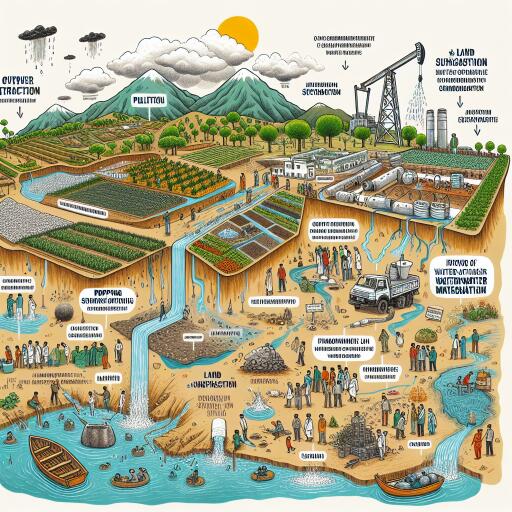
Problems and Management of Groundwater in J&K: A Crucial Ecological Concern
Water, the essence of life, holds unparalleled significance for all living beings on our planet. Its availability and quality dictate the health and survival of ecosystems, agriculture, and human societies. Globally, freshwater sources are under significant stress due to various anthropogenic and natural factors. In India, a nation blessed with diverse water resources ranging from majestic rivers to vast underground aquifers, the challenge of managing water, particularly groundwater, is acute. This is notably exemplified in the Jammu and Kashmir (J&K) region, where groundwater management presents unique challenges and opportunities.
Understanding Groundwater Dynamics
Groundwater, stored in aquifers below the Earth’s surface, is a critical component of the planet’s water cycle and a primary source of freshwater for agricultural, industrial, and domestic uses. The efficiency of groundwater usage dictates not only the immediate availability of water but also the long-term sustainability of this hidden trove. However, relentless extraction and pollution have imperiled its existence, particularly in regions where it serves as a lifeline for communities and ecosystems.
Unpacking the Challenges
In J&K, the challenges surrounding groundwater management are twofold, involving both contamination and over-extraction. Rapid industrialization and urbanization have exacerbated these problems, pushing the aquifers to the brink of depletion. Excessive withdrawals for irrigation, domestic use, and industrial processes have led to significant drops in groundwater levels, disturbing the delicate balance of aquifer recharge and discharge.
Pollution further complicates the scenario. Runoff from agricultural lands, laden with fertilizers and pesticides, seeps into the groundwater, while untreated or inadequately treated industrial effluents introduce hazardous chemicals. Urban areas, without proper waste disposal and sewage treatment facilities, contribute to the contamination, jeopardizing water quality and public health.
These challenges are compounded by the geological vulnerability of the region. Certain districts have reported concerning levels of nitrate and fluoride, indicative of both anthropogenic pollution and natural geological processes. This scenario underscores the need for a comprehensive understanding of the local geological context in managing groundwater quality.
Climate Change: The Emerging Threat
Climate variation introduces a new dimension to groundwater management. Changes in precipitation patterns and increased rates of evaporation due to rising temperatures could further stress already vulnerable aquifers, hindering natural recharge processes and affecting the overall water balance in the region.
Propelling Towards Sustainable Management
Aquifer management demands a science-based, holistic approach. Sound policies and practices should be underpinned by a thorough understanding of groundwater dynamics, including recharge areas, flow patterns, and interaction with surface water bodies. Leveraging modern technologies such as computational modelling, artificial intelligence, and remote sensing can provide valuable insights for effective groundwater management strategies.
Preventive measures are paramount for safeguarding groundwater quality. Implementing stricter regulations on pollutants, promoting sustainable agricultural practices, and enhancing wastewater treatment infrastructures are critical steps. Moreover, community engagement and education on the importance of water conservation can foster collective action towards groundwater sustainability.
Future Paths
To secure the future of groundwater in J&K and beyond, a multifaceted approach is necessary. This includes establishing comprehensive data sets through remote sensing and GIS technologies, which help in understanding and monitoring groundwater systems. Groundwater management must integrate with broader ecological and water resource policies to ensure a sustainable balance between usage and replenishment.
Strategic rainwater harvesting, rejuvenation of traditional water bodies, and the adoption of water-saving technologies in agriculture and industry can augment groundwater recharge. Moreover, understanding anthropogenic impacts and prioritizing groundwater in planning and development processes are critical for long-term conservation efforts.
In conclusion, the path to sustainable groundwater management in J&K hinges on a combination of science-based policies, technology, community participation, and regulatory frameworks. By addressing the challenges head-on and embracing innovative solutions, the region can secure its water future, ensuring that this precious resource continues to sustain life and livelihoods for generations to come.





Leave a Reply